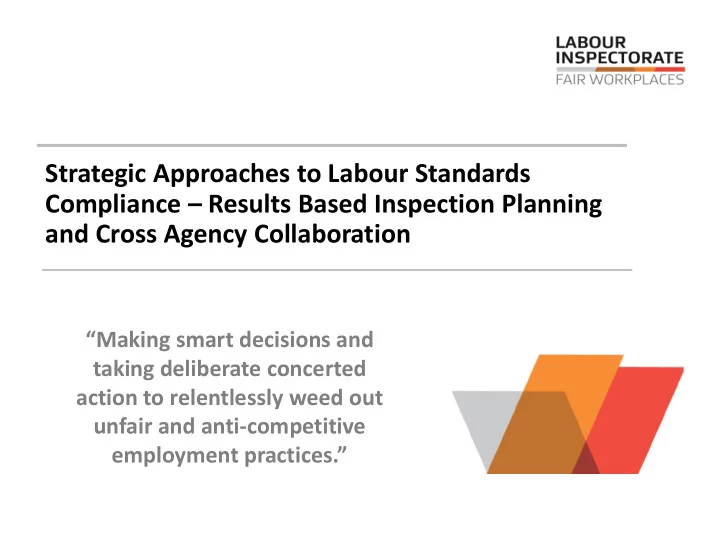

Strategic Approaches to Labour Standards Compliance – Results Based Inspection Planning and Cross Agency Collaboration “Making smart decisions and taking deliberate concerted action to relentlessly weed out unfair and anti-competitive employment practices.”
Elements of the NZ Strategic Approach • Conceiving the mission • Understanding context • Identifying and leveraging relevant systems • Involving others • Driving demand • Supporting supply • Avoiding ‘moral hazards’
A Systems Approach • Identify relevant regulatory and business systems • Use an industry/sector lens to reach into those systems • Drive demand for changes/enhancement to those systems vis a vis employment standards by highlighting risk and weakness through enforcement and associated publicity • Support system owners to make the necessary changes/enhancements
Key Questions For Initiatives • What is the problem? • What is the result? – First order consequences – Second and third order consequences • What method and what action? – Initially (enforcement) – Relationship building – Support • Who needs to be involved? – Other agencies – Industry bodies – Media • How? – Shared outcomes – Framing co-incidence of interest (downside risk/upside value)
Horticulture (Global GAP (GRASP)) • Problem – ‘criminal’ gangs increasingly prevalent in providing labour to the horticulture industry • Result – obtain routine labour standards assurance in a key export industry reliant on brand and already utilising audit • Method – use international customer demand for assurance off the back of highlighted failure of customer expectation • Action – joint agency enforcement (labour standards, trafficking and fraud), vulnerable worker lens, publicity (including international) • Involvement of Others - immigration/revenue, peak bodies, 3 rd party auditors, innovators • Progress Report – widespread media publicity, (international), international customer engagement, first Global GAP (GRASP) audits undertaken by 3 rd party auditor, new immigration policies, new tools to support compliance emerging
Dairy (Workplace Action Plan) • Problem – long hours, low pay and poor labour models alienating local workforce with increasing reliance on vulnerable migrants • Result – lift labour standards on farm in a highly integrated commodity supply chain with migrant labour component • Method – highlight problems publicly, leverage existing industry strategy, work to create industry leadership for labour standards, progressively build into supply chain standards and assurance, continue monitoring and feedback • Action - labour standards (non-compliance/ exploitation, immigration fraud), publicity (local) • Involvement of Others - peak bodies, training • Progress Report – widespread media publicity, strong farmer leadership (Workplace Action Plan), technological innovation, changing business practices, higher parts of value chain ‘coming on board’
Cleaning Services (Govt Procurement) • Problem – government opportunity to reframe purchasing and insist on additional supply chain integrity • Result – get the government procurement system (30% of NZ GDP) to specifically address labour standard in the ‘at risk’ elements of the workforce • Action – engagement with lead procurement agency, build capability/resources, look for/create opportunities in relation to higher risk activities • Involvement of Others - government procurement, peak bodies, 3 rd party auditors • Method – leverage govt’s low tolerance for risk and desire to ‘do the right thing’, support tendering contract process in a key area of vulnerability risk, support leadership aspirations of key industry body (Building Services Contractors (BSC)), monitor • Progress Report – Govt procurement to require labour standards compliance to be demonstrated in cleaning contracts, BSC to audit own members under their industry code, LI to pro-actively inspect
Hospitality (Immigration Stand-downs) • Problem – new ethnic business owners employing and exploiting migrant workers in low cost hospitality and expanding the model through chains/franchising • Result – engage consumers to make better choices, motivate Govt to be more discerning with labour supply, ‘shock’ and drive demand for peak body support • Method – highlight weakness and failure in the immigration system • Action – joint agency enforcement (labour standards, fraud, revenue, proceeds of crime), vulnerable worker lens, domestic publicity, reframe standards abuse, changes to immigration policy settings, seize ‘tainted assets’ beyond corporate veil • Involvement of Others - immigration visa and compliance/revenue/police, immigration policy branch • Progress Report – new immigration policy preventing employers who breach labour standards from accessing migrant labour, growing domestic consumer engagement, emphatic deterrence statement, industry bodies engaged with education offering.
Retail Liquor (Liquor License Loss) • Problem – new ethnic business owners employing and exploiting migrant workers in low quality retail and expanding the model • Result – incorporate labour standards as part of the criteria for sale of liquor, present owners with the choice of lifting standards or going out of business, lift capability of liquor licensing laws and authorities • Method – leverage legally proven employment law breaches in liquor licensing applications, put employers out of business • Action - uncompromising enforcement action, asset freezing, insolvency, teaming with local councils, supporting opposition to liquor licenses, widespread publicity • Involving Others – immigration, local councils, police • Progress Report – number liquor licenses declined, transfer of businesses, high penalties imposed, increasing community support, body of case law to promote liquor licensing law reform.
The Future – LI as an Information Flow?
Recommend
More recommend